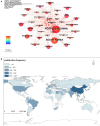Applications of Traditional Herbal Ingredients in Skincare: Mapping the Research Landscape and Innovation Trajectories Over Four Decades
- PMID: 40686194
- PMCID: PMC12278037
- DOI: 10.1111/jocd.70363
Applications of Traditional Herbal Ingredients in Skincare: Mapping the Research Landscape and Innovation Trajectories Over Four Decades
Abstract
Objective: Along with economic and technological advancements, traditional herbal ingredients have garnered increasing attention in skincare due to their antioxidative properties, low toxicity, multitargeted effects, and broad cultural acceptance. However, there remains a lack of comprehensive knowledge frameworks and systematic research trend analyses in this field. This study examines the scientific landscape and innovation patterns of herbal skincare, aiming to establish a framework for integrating traditional wisdom with modern dermatological science.
Methods: A systematic literature search was conducted in the Web of Science Core Collection (SCI-E). CiteSpace, VOSviewer, and ArcGIS were employed to analyze leading contributors, research trends, and thematic evolutions.
Results: The analysis yielded 1593 papers authored by 753 researchers from 507 institutions across 102 countries. China emerged as the top contributor, while Industrial Crops and Products was the most highly cited journal, and Zengin, Gokhan, was the most prolific author. Geographical clustering and cultural convergence characterized the distribution of countries, institutions, and authors. Keyword clustering identified 20 research networks, with recent clusters including #6 "molecular docking," #7 "chromatography-mass spectrometry," and #15 "mixture design." Persistently trending keywords included "Mechanism," "Gut microbiota," "Network pharmacology," and "Association."
Conclusion: Research on herbal skincare has evolved from raw plant usage to advanced refinement techniques, spanning animal, cellular, and molecular studies, including high-throughput screening approaches. Formulations have progressed from complex mixtures to single-compound extractions and bioactive monomers. A comprehensive research system has been established, yet standardization in dosage, application, and manufacturing remains crucial. Future studies should prioritize multicenter clinical trials and evidence-based validation. This study highlights the transition from empirical herbal applications to precision skincare, advocating for global collaboration between traditional medicine and modern regulatory science.
Keywords: healthy skin; herbs; plants; skin care.
© 2025 The Author(s). Journal of Cosmetic Dermatology published by Wiley Periodicals LLC.
Conflict of interest statement
The authors declare no conflicts of interest.
Figures







Similar articles
-
Chinese herbal medicine for chronic pain: a bibliometric analysis based on integrated databases (2011-2024).Front Med (Lausanne). 2025 Aug 8;12:1642093. doi: 10.3389/fmed.2025.1642093. eCollection 2025. Front Med (Lausanne). 2025. PMID: 40861240 Free PMC article.
-
Research status, hotspots and perspectives of artificial intelligence applied to pain management: a bibliometric and visual analysis.Updates Surg. 2025 Jun 28. doi: 10.1007/s13304-025-02296-w. Online ahead of print. Updates Surg. 2025. PMID: 40580377
-
Driving innovations in cancer research through spatial metabolomics: a bibliometric review of trends and hotspot.Front Immunol. 2025 Jun 10;16:1589943. doi: 10.3389/fimmu.2025.1589943. eCollection 2025. Front Immunol. 2025. PMID: 40557160 Free PMC article.
-
A bibliometric analysis of research trends in mesenchymal stem cell therapy for neonatal bronchopulmonary dysplasia: 2004-2024.Front Pediatr. 2025 Jun 3;13:1558301. doi: 10.3389/fped.2025.1558301. eCollection 2025. Front Pediatr. 2025. PMID: 40530182 Free PMC article. Review.
-
[Volume and health outcomes: evidence from systematic reviews and from evaluation of Italian hospital data].Epidemiol Prev. 2013 Mar-Jun;37(2-3 Suppl 2):1-100. Epidemiol Prev. 2013. PMID: 23851286 Italian.
References
-
- Proksch E., Brandner J. M., and Jensen J. M., “The Skin: An Indispensable Barrier,” Experimental Dermatology 17, no. 12 (2008): 1063–1072. - PubMed
-
- Dion K., Berscheid E., and Walster E., “What Is Beautiful Is Good,” Journal of Personality and Social Psychology 24, no. 3 (1972): 285–290. - PubMed
-
- Draelos Z. D., “The Science Behind Skin Care: Cleansers,” Journal of Cosmetic Dermatology 17, no. 1 (2018): 8–14. - PubMed
-
- Ahuja A., Gupta J., and Gupta R., “Miracles of Herbal Phytomedicines in Treatment of Skin Disorders: Natural Healthcare Perspective,” Infectious Disorders Drug Targets 21, no. 3 (2021): 328–338. - PubMed
Publication types
MeSH terms
Substances
Grants and funding
LinkOut - more resources
Full Text Sources
Medical

